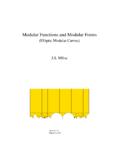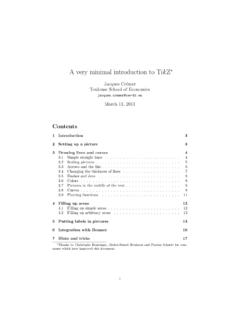Transcription of The tikz package
1 ThetikzpackageThis is a general purpose graphics package . To load it for this document, I used:\usepackage{tikz}\usetikzlibrary{ma trix,arrows, }There are now three ways to enter commutative diagrams usingtikz: with the package tikz-cd,withmatrix, and directly withtikz(listed roughly in order of decreasing ease but increasingflexibility).Aa B yb ycCd D$\begin{CD}A@>a>>B\\@VVbV@VVcV\\C@>d>>D \end{CD}$(amscd)ABCD abcd\begin{tikzcd}A \arrow{r}{a} \arrow{d}{b}&B \arrow{d}{c}\\C \arrow{r}{d} &D\end{tikzcd}(tikz-cd)ABCD abcd\begin{tikzpicture}\matrix(m)[matrix of math nodes,row sep= , column sep= ,text height= , text depth= ]{A&B\\C \path[->,font=\scriptsize,>=angle 90](m-1-1) edge node[auto] {$a$} (m-1-2)edge node[auto] {$b$} (m-2-1)(m-1-2) edge node[auto] {$c$} (m-2-2)(m-2-1) edge node[auto] {$d$} (m-2-2).}
2 \end{tikzpicture}(matrix)ABCD abcd\begin{tikzpicture}[scale= ]\node (A) at (0,1) {$A$};\node (B) at (1,1) {$B$};\node (C) at (0,0) {$C$};\node (D) at (1,0) {$D$};\path[->,font=\scriptsize,>=angle 90](A) edge node[above]{$a$} (B)(A) edge node[right]{$b$} (C)(B) edge node[right]{$c$} (D)(C) edge node[above]{$d$} (D);\end{tikzpicture}(tikz)This is part of: Guide to Commutative Diagrams, revised October 30, 20121 Usingtikz-cdLoad1this with\usepackage{tikz-cd}. As the code on illustrates, the syntax fortikz-cdissimilar to that of array. Note thattikz-cdhandles large objects and tall labels better thanamscd:A A A A A ABCD abcdABCDabcAAAThe next example illustrates the use of different arrows in a commutative diagram:ABCD\begin{tikzcd}A \arrow[hook]{r}\arrow[two heads]{rd}&B \arrow[dotted]{d}\arrow[hookleftarrow]{r }&C \arrow[two heads]{ld}\\&D\end{tikzcd}Now an example with labels on the arrows.
3 ABCD ububrlubbu\begin{tikzcd}A \arrow[hook]{r}{u}[swap]{b}\arrow[two heads]{rd}{u}[swap]{b}&B \arrow[dotted]{d}{r}[swap]{l}\arrow[hook leftarrow]{r}{u}[swap]{b}&C \arrow[two heads]{ld}{b}[swap]{u}\\&D\end{tikzcd}Lo ng labels may cause problems:ABCDEF very long label\begin{tikzcd}A\arrow{r}\arrow{d}&B \arrow{r}{\text{very long label}}\arrow{d}&C\arrow{d}\\D\arrow{r}& E\arrow{r}&F\end{tikzcd}However, this can be fixed as follows:ABCDEF very long label\begin{tikzcd}[column sep=large]A\arrow{r}\arrow{d}..tikz-cddo es not have a problem with objects of different heights.
4 A n ZAn n usingtikz-cd, check that your TEX installation is using version ofpgf you can do this by runningTEX on a file containing\ arrows is \begin{tikzcd}A\arrow[bend left]{r}\arrow[bend right]{r}&B\end{tikzcd}When a diagram is numbered, this is placed correctly:ABCD abcd(1)Two more examples:ABCDEF fcde\begin{tikzcd}&A\arrow{ldd}[swap]{f} \arrow{rd}[description]{c}\arrow{rrd}[de scription]{d}\arrow{rrrd}[description]{e }\\&B\arrow{ld}\arrow{r}&C\arrow{r}&D\ar row{r}&E\\F\end{tikzcd}TX ZYXYZxy(x,y)pqfg\begin{tikzcd}T\arrow[be nd left]{drr}{x}\arrow[bend right]{ddr}[swap]{y}\arrow[dotted]{dr}[d escription]{(x,y)}
5 } & & \\& X \times_Z Y \arrow{r}{p} \arrow{d}{q} & X \arrow{d}{f} \\& Y \arrow{r}{g} & Z\end{tikzcd}3 UsingmatrixThe code on sets up a matrix namedmwith some options, and then placesA,B,C, andDatthe four positions of a 2 2 matrix. The next line specifies normal arrows with labels in scriptsizeand a nondefault arrow head, and the following line specifies an arrow from the (1,1) position of thematrixmto the (1,2) position with a labelain the default thattikzhandles large objects and tall labels better than amscd:A A A A A ABCD abcdABCDAAATo my eyes, the arrow heads are too can be fixed by adding>=angle 90, as anoption to the path or to the whole picture:\path[->](1,1) edge (2,1);\path[->,>=angle 90](1,1) edge (2,1);Here is the code for some arrows.
6 \path[->](1,1) edge (2,1);\path[|->](1,1) edge (2,1);\path[-](1,1) edge (2,1);\path[right hook->](1,1) edge (2,1);\path[->>](1,1) edge (2,1);\path[dotted,->](1,1) edge (2,1);\path[dashed,->](1,1) edge (2,1);\path[*->](1,1) edge (2,1);\draw[double distance = ](1,1) -- (2,1); next example illustrates the use of the different arrows in a commutative diagramABCD\begin{tikzpicture}[>=angle 90]\matrix(a)[matrix of math nodes,row sep=3em, column sep= ,text height= , text depth= ]{A&B \path[right hook->](a-1-1) edge (a-1-2);\path[->>](a-1-1) edge (a-2-2);\path[dotted,->](a-1-2) edge (a-2-2);\path[left hook->](a-1-3) edge (a-1-2);\path[->>](a-1-3) edge (a-2-2);\end{tikzpicture}2 an erudite discussion of this problem, with an example with labels on the arrows:ABCD ububububub\path[right hook->,font=\scriptsize](a-1-1) edge node[above]{$u$}node[below]{$b$} (a-1-2);\path[->>,font=\scriptsize](a-1- 1) edge node[above]{$u$}node[below]{$b$} (a-2-2)(a-1-3) edge node[above left]{$u$}node[below right]{$b$} (a-2-2).}
7 \path[dotted,->,font=\scriptsize](a-1-2) edge node[left]{$u$}node[right]{$b$} (a-2-2);\path[left hook->,font=\scriptsize](a-1-3) edge node[above]{$u$}node[below]{$b$} (a-1-2);Long labels may cause a problem:ABCDEF very long label\begin{tikzpicture}\matrix(m)[matri x of math nodes,row sep=3em, column sep= ,text height= , text depth= ]{A&B&C\\D \path[->,font=\scriptsize](m-1-1) edge (m-1-2)edge (m-2-1)(m-1-2) edge node[auto] {very long label} (m-1-3)edge (m-2-2)(m-1-3) edge (m-2-3)(m-2-1) edge (m-2-2)(m-2-2) edge (m-2-3);\end{tikzpicture}However, this can be fixed by settingcolumn sep= long labeltikzdoes not have a problem with objects of different heights.}
8 A n ZAn n that is because of the optionstext height= , text depth= When you omit5them, you get: A n ZAn n arrows is \begin{tikzpicture}\matrix(m)[matrix of math nodes,row sep=3em, column sep= ,text height= , text depth= ]{A \path[->](m-1-1) edge [bend left] (m-1-2)edge [bend left=40] (m-1-2)edge [bend left=60] (m-1-2)edge [bend left=80] (m-1-2)edge [bend right] (m-1-2);\end{tikzpicture}Arrows may not attach themselves correctly to the nodes:H2(L/K)0Br(L/K) vBr(Lv/Kv)Q/ZTo fix this, use( east) edge (m-1-4)( east) edge (m-3-4);H2(L/K)0Br(L/K) vBr(Lv/Kv)Q/Z6 Two more examples:ABCDEF fcde\[\begin{tikzpicture}[descr/.]]}
9 Style={fill=white}]\matrix(m)[matrix of math nodes, row sep=3em, column sep= ,text height= , text depth= ]{&A\\&B&C&D \path[->,font=\scriptsize](m-1-2) edge node[above left] {$f$} (m-3-1)edge node[descr] {$c$} (m-2-3)edge node[descr] {$d$} (m-2-4)edge node[descr] {$e$} (m-2-5);\path[->](m-2-2) edge (m-3-1)edge (m-2-3);\path[->](m-2-3) edge (m-2-4);\path[->](m-2-4) edge (m-2-5);\end{tikzpicture}\]TX ZYXYZxy(x,y)pqfg\[\begin{tikzpicture}[de scr/.style={fill=white}]\matrix(m)[matri x of math nodes, row sep=3em, column sep= ,text height= , text depth= ]{T\\&X\times_Z Y&X\\ 7\path[->,font=\scriptsize](m-1-1) edge [bend left=10] node[above] {$x$} (m-2-3)(m-1-1) edge [bend right=10] node[below] {$y$} (m-3-2);\path[->,dotted,font=\scriptsize ](m-1-1) edge node[descr] {$(x,y)$} (m-2-2);\path[->,font=\scriptsize](m-2-2 ) edge node[below] {$p$} (m-2-3)(m-2-2) edge node[right] {$q$} (m-3-2);\path[->,font=\scriptsize](m-2-3 ) edge node[right] {$f$} (m-3-3).}}
10 \path[->,font=\scriptsize](m-3-2) edge node[above] {$g$} (m-3-3);\end{tikzpicture}\]8 UsingtikzdirectlyInstead of using a matrix grid, you can usetikzpicturedirectly to construct a \begin{tikzpicture}\node (A) at (-1,0) {$A$};\node (B) at (1,0) {$B$};\node at (0,0) {\rotatebox{270}{$\Rightarrow$}};\path[- >,font=\scriptsize,>=angle 90](A) edge [bend left] node[above] {$\alpha$} (B)edge [bend right] node[below] {$\beta$} (B);\end{tikzpicture}(rotateboxrequiresg raphicx.)X (Y (Z T))X ((Y Z) T))(X (Y Z)) T((X Y) Z) T(X Y) (Z T)1 1 Pentagon Axiom\begin{tikzpicture}\node (P0) at (90 ) {$X\otimes (Y\otimes (Z\otimes T))$};\node (P1) at (90+72 ) {$X\otimes ((Y\otimes Z)\otimes T))$} ;\node (P2) at (90+2*72 ) {$\mathllap{(X\otimes (Y\otimes Z))}\otimes T$};\node (P3) at (90+3*72 ) {$((X\otimes Y)\mathrlap{\otimes Z)\otimes T}$};\node (P4) at (90+4*72 ) {$(X\otimes Y)\otimes (Z\otimes T)$}.















